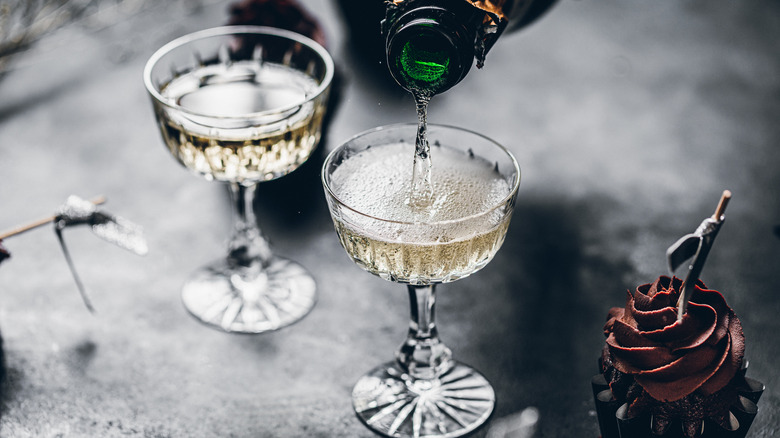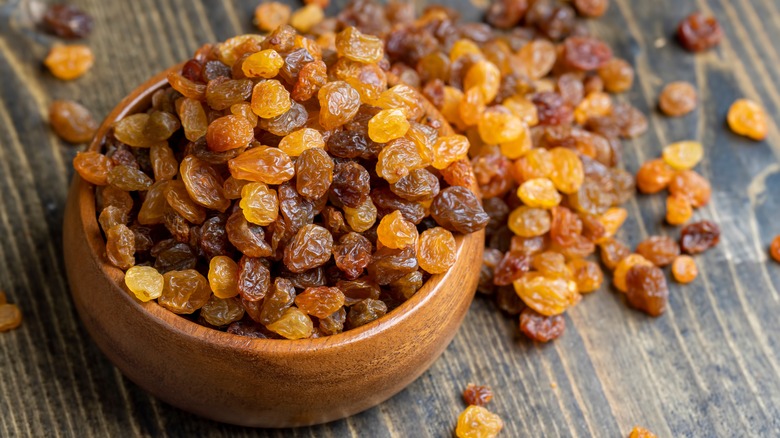Can You Make Flat Champagne Bubbly Again With A Single Raisin?
A good glass of wine can make any occasion feel more festive, especially when it's sparkling. But once you pop the cork off of your bottle of Champagne, prosecco, or cava, the clock starts ticking — it's only a matter of time before those bubbles escape and your wine goes from effervescent to flat. But there may be a trick that you can use to bring the sparkle back to your beverage.
Some say that a single raisin can pretty much perform a magic trick by reviving the fizz in your vino. All you need to do is drop one raisin into a bottle of sparkling wine or Champagne that has started to go flat. The raisin will then attract any dissolved carbon dioxide and the beverage will begin to bubble again. In 2017, Hoda Kotb and Jenna Bush Hager demonstrated the trick (which they said they learned from PureWow) on the Today Show. After dropping a raisin into a day-old bottle of Champagne, it became visibly more bubbly, and the same occurred when they placed the raisin into a single glass of the Champagne, as well.
Numerous other outlets have published the same information or done their own demonstrations. However, one controlled experiment seems to reveal that, like most things that seem too good to be true, the raisin trick may not be able to revive your sparkling wine.
Does the raisin trick work?
To test the theory that raisins can breathe new life into a bubbly beverage, experimenters at America's Test Kitchen used two four-day-old bottles of Champagne that had been left open. After placing a raisin in one, they did observe the release of bubbles in the bottle. However, taste testers reported no discernible differences between the two bottles. Furthermore, when comparing the older Champagne with a fresh bottle, the experimenters reported that the former was inferior in terms of both fizziness and aroma.
While the raisin did cause at least a temporary increase in the number of bubbles, the experiment seems to suggest that you're unlikely to be able to capture the original flavor and mouthfeel of your sparkling wine or Champagne that's been left open, even when trying this hack. But there could be another factor at play that caused different results.
Depending on the circumstances, ranging from temperature to how bubbly the Champagne was to start with (not all sparkling wines are created equal when it comes to carbon dioxide content), it can be just a matter of hours before Champagne goes flat. For this experiment, the bottles used were four days old, creating an enormous disparity in the amount of time the carbon dioxide had to escape from the bottle. After all, the wrinkly raisin's skin is merely capturing and redistributing the carbon dioxide that's remaining in the Champagne, not creating it.
Tips to keep Champagne bubbly
Just because you may not be able to make your Champagne fully fizzy again doesn't mean you have to drink the whole bottle at once, lest you wind up with completely flat wine in a few hours. There are a few ways that you can preserve your bubbly and slow down the process of it going flat. Firstly, always store leftover sparkling wine or Champagne in the refrigerator to keep it as fresh as possible. And though you can't reinsert the cork into the bottle, like you can with other types of wine, you can invest in a stopper intended for the preservation of sparkling wine. Or, just tightly wrap aluminum foil over the top of the bottle.
If you try all of these methods and your Champagne still goes flat, it's certainly still drinkable, if less exciting. But if you can't bear to sip on your sparkling wine that's now bereft of bubbles, repurpose it by cooking with it, like you would any white wine with a similar flavor profile. A dry version can be added to soups, used when braising turkey, or in a simple pasta dish like linguini con vongole. Sweeter sparkling wines might be more suited to desserts or cocktails.



